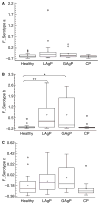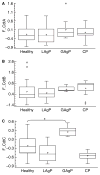Immune response to cytolethal distending toxin of Aggregatibacter actinomycetemcomitans in periodontitis patients
- PMID: 20337882
- PMCID: PMC3534802
- DOI: 10.1111/j.1600-0765.2009.01260.x
Immune response to cytolethal distending toxin of Aggregatibacter actinomycetemcomitans in periodontitis patients
Abstract
Background and objective: Cytolethal distending toxin (CDT) is a genotoxin produced by Aggregatibacter actinomycetemcomitans. In spite of its association with pathogenesis, little is known about the humoral immune response against the CDT. This study aimed to test whether subgingival colonization and humoral response to A. actinomycetemcomitans would lead to a response against CDT.
Material and methods: Sera from periodontally healthy, localized and generalized aggressive periodontitis and chronic periodontitis subjects (n = 80) were assessed for immunoglobulin G titers to A. actinomycetemcomitans serotypes a/b/c and to each CDT subunit (CdtA, CdtB and CdtC) by ELISA. A. actinomycetemcomitans subgingival levels and neutralization of CDT activity were also analyzed.
Results: Sera from 75.0% localized and 81.8% generalized aggressive periodontitis patients reacted to A. actinomycetemcomitans. A response to serotype b was detected in localized (66.7%) and generalized aggressive periodontitis (54.5%). Reactivity to A. actinomycetemcomitans correlated with subgingival colonization (R = 0.75, p < 0.05). There was no correlation between A. actinomycetemcomitans colonization or response to serotypes and the immunoglobulin G response to CDT subunits. Titers of immunoglobulin G to CdtA and CdtB did not differ among groups; however, sera of all generalized aggressive periodontitis patients reacted to CdtC. Neutralization of CDT was not correlated with levels of antibodies to CDT subunits.
Conclusion: Response to CdtA and CdtB did not correlate with the periodontal status of the subject in the context of an A. actinomycetemcomitans infection. However, a response to CdtC was found in sera of generalized but not of localized aggressive periodontitis subjects. Differences in response to CdtC between generalized and localized aggressive periodontitis subjects indicate that CDT could be expressed differently by the infecting strains. Alternatively, the antibody response to CdtC could require the colonization of multiple sites.
Figures




References
-
- Henderson B, Wilson M, Sharp L, Ward JM. Actinobacillus actinomycetemcomitans. J Med Microbiol. 2002;51:1013–1020. - PubMed
-
- Fives-Taylor PM, Meyer DH, Mintz KP, Brissette C. Virulence factors of Actinobacillus actinomycetemcomitans. Periodontol 2000. 1999;20:136–167. - PubMed
-
- Wang D, Kawashima Y, Nagasawa T, et al. Elevated serum IgG titer and avidity to Actinobacillus actinomycetemcomitans serotype c in Japanese periodontitis patients. Oral Microbiol Immunol. 2005;20:172–179. - PubMed
-
- Rylev M, Kilian M. Prevalence and distribution of principal periodontal pathogens worldwide. J Clin Periodontol. 2008;8(Suppl):346–361. - PubMed
Publication types
MeSH terms
Substances
Grants and funding
LinkOut - more resources
Full Text Sources
Molecular Biology Databases

